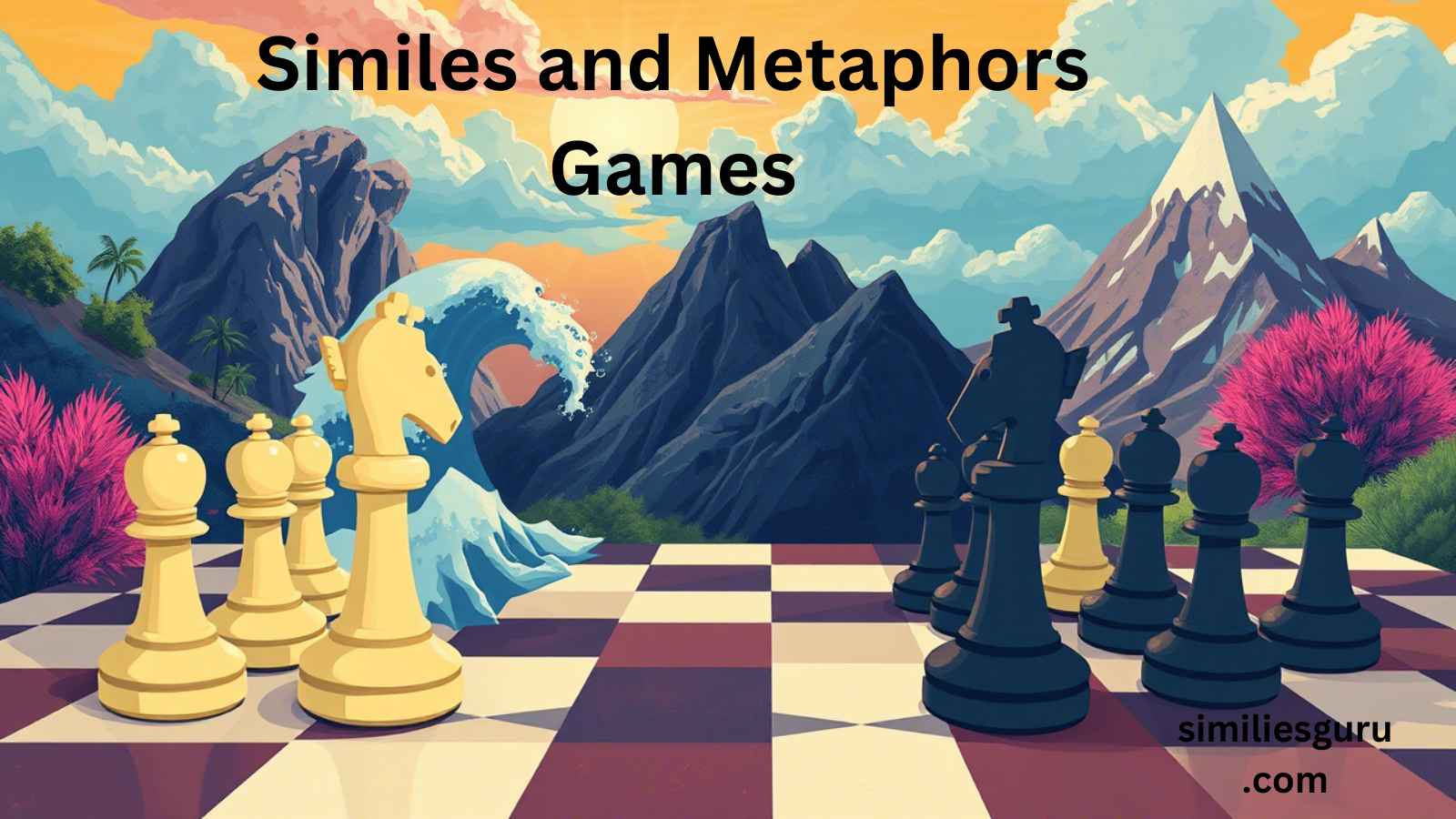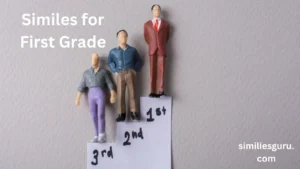Similes and metaphors are powerful tools in the English language, helping to add color, depth, and creativity to speech and writing. For 4th graders, learning these figures of speech can be an exciting journey, unlocking a new world of expression. One fun way to explore similes and metaphors is through interactive games that help students understand and practice these concepts in a playful, engaging way.
In this article, we’ll dive into 10+ creative similes and metaphors games for 4th graders. We’ll explore different variations of how to teach these literary devices and provide alternatives in both formal and casual contexts. Whether you’re an educator, a parent, or simply a language enthusiast, these games will help students grasp the nuances of similes and metaphors while also having fun. Alongside these games, we’ll provide examples of polite, professional, and casual alternatives for introducing similes and metaphors in conversations. Let’s dive in!
1. Simile Scavenger Hunt
Game Overview:
This game involves students searching for objects around the classroom or home that could represent specific similes. For example, “as shiny as a star” might lead them to find a shiny object, and “as soft as a pillow” could bring them to a cozy cushion. The goal is to make the connection between the descriptive simile and real-world objects.
Polite Alternative:
In a classroom setting, you could say, “We’re going to embark on a fun scavenger hunt where we explore similes through objects we encounter.”
Casual Alternative:
“You’ll be hunting for stuff that fits similes like ‘as bright as a lightbulb’—it’s a bit like treasure hunting!”
Example:
- “Can you find something ‘as smooth as silk’?”
- “Look for something ‘as cold as ice.’”
2. Metaphor Charades
Game Overview:
In this game, students take turns acting out a metaphor without using words, while the rest of the class guesses the metaphor. For example, if the metaphor is “He’s a walking encyclopedia,” the student might pretend to read a book or mimic the motion of flipping through pages.
Professional Alternative:
This activity encourages students to connect abstract ideas with physical actions, helping them understand metaphorical language and its impact.
Casual Alternative:
“Let’s play charades with metaphors! You’ll act out phrases like ‘she’s a shining star,’ and we’ll guess.”
Example:
- “He’s a giant teddy bear” (for a kind, big person).
- “She’s a ray of sunshine” (for a positive, cheerful person).
3. Simile and Metaphor Matching Game
Game Overview:
Create a set of cards with different similes and metaphors written on them. On one set of cards, write descriptive phrases like “as busy as a bee” or “a heart of gold.” On another set, write their meanings or matching visual representations. Students must match the cards correctly.
Polite Alternative:
“Let’s test your knowledge of similes and metaphors by matching the descriptions with their meanings.”
Casual Alternative:
“Time for a matching game! Let’s pair similes and metaphors with their meanings!”
Example:
- Match “as cool as a cucumber” with “someone who remains calm under pressure.”
- Match “the world is a stage” with “life is like a performance.”
4. Simile & Metaphor Story Creation
Game Overview:
Students work in pairs or small groups to create short stories that incorporate a list of given similes and metaphors. Afterward, they can present their stories to the class.
Professional Alternative:
“Let’s apply our understanding of similes and metaphors by crafting a short story with these literary devices.”
Casual Alternative:
“Grab your buddies, make up a cool story, and use as many similes and metaphors as you can!”
Example:
- “Her voice was as smooth as honey, and she had the wisdom of an old oak tree.”
- “The night sky was a blanket of stars, and the city below was a buzzing hive of activity.”
5. Metaphor Pictionary
Game Overview:
This game works similarly to the classic game of Pictionary, but with metaphors. Students draw the meaning behind a metaphor for the rest of the class to guess. For example, for “a fish out of water,” they could draw someone struggling to breathe on land.
Polite Alternative:
“Let’s enhance our understanding of metaphors by visually representing them through drawings.”
Casual Alternative:
“Time to grab some markers! We’re drawing metaphors—no words, just pictures.”
Example:
- Drawing “a thorn in my side” (representing a problem or annoyance).
- Drawing “a sea of troubles” (representing overwhelming challenges).
6. Simile and Metaphor Bingo
Game Overview:
Create bingo cards with various similes and metaphors in each square. Call out the meanings or definitions, and students mark the corresponding simile or metaphor on their cards.
Polite Alternative:
“We’ll be playing a version of bingo where the squares are filled with similes and metaphors based on their definitions.”
Casual Alternative:
“Let’s play bingo with similes and metaphors! I’ll call out the meanings, and you mark the right ones.”
Example:
- “As fast as lightning” (for a quick runner).
- “The world is your oyster” (for someone with endless possibilities).
7. Simile & Metaphor Poetry Challenge
Game Overview:
Challenge students to write poems using a list of provided similes and metaphors. The twist is that they must weave them into a creative piece that flows well, encouraging students to think critically about language and rhythm.
Professional Alternative:
“Let’s exercise our poetic skills by integrating similes and metaphors into a short poem.”
Casual Alternative:
“Let’s get creative! Write a poem using as many metaphors and similes as you can!”
Example:
- “Her laugh was a melody, as sweet as a bird’s song.”
- “His words were like a storm, fast and powerful.”
8. Metaphor Dictionary
Game Overview:
Ask students to create a “metaphor dictionary” where they write a metaphor and provide its meaning. They can draw illustrations for each metaphor to enhance understanding. This game helps deepen their comprehension of figurative language.
Professional Alternative:
“Create your own metaphor dictionary, complete with definitions and visual representations for each metaphor.”
Casual Alternative:
“Time to make a cool metaphor dictionary! Write down some metaphors and draw what they mean.”
Example:
- “A cold shoulder” (to ignore or reject someone).
- “The apple of my eye” (someone who is cherished or loved).
9. Simile and Metaphor Fill-in-the-Blanks
Game Overview:
Create sentences with blanks where students need to fill in the appropriate simile or metaphor. For example, “Her smile was as bright as _____,” or “He was a _____ in the schoolyard.”
Professional Alternative:
“Fill in the blanks with the correct similes or metaphors to complete the sentence meaningfully.”
Casual Alternative:
“Let’s fill in the blanks! What’s the perfect metaphor or simile for these sentences?”
Example:
- “Her skin was as soft as ______.”
- “He’s a _____ when it comes to problem-solving.”
10. Simile & Metaphor Word Search
Game Overview:
Create a word search with hidden similes and metaphors. Students must find and circle the literary devices within the puzzle. This game helps reinforce vocabulary recognition.
Polite Alternative:
“Engage in a fun word search activity where you’ll find hidden similes and metaphors.”
Casual Alternative:
“Let’s hunt down some similes and metaphors in this word search!”
Example:
Look for phrases like:
- “As tough as nails”
- “A diamond in the rough”
Conclusion
Similes and metaphors are fun and powerful literary devices that help 4th graders not only enhance their writing but also foster creativity and critical thinking. These 10+ games are designed to make learning about figurative language both engaging and educational. By incorporating various teaching techniques, from scavenger hunts to Pictionary-style drawing, students can better understand and internalize the nuances of similes and metaphors.
With these activities, educators and parents can ensure that kids are having fun while learning, promoting a deeper appreciation for language.



